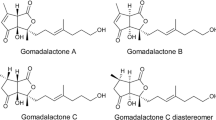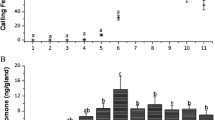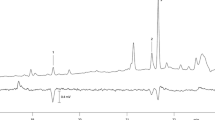Abstract
The macrocyclic lactones found in the Dufour's gland of the halictine beeLasioglossum zephyrum are female sex pheromones. Octadecanolide, eicosanolide, docosanolide, and tetracosanolide, as well as monounsaturated homologs of each, are components of the Dufour's gland secretion of this species. Furthermore, a series of odd-carbon-numbered saturated and unsaturated hydrocarbons and isopentenyl docosanoate occur in extracts of the Dufour's gland and of whole females. Two different mixtures of all four synthetic lactones, and additionally a treatment consisting of the natural extract, elicit higher response levels than two of the lactones separately or either of the controls.
Similar content being viewed by others
References
Bateson, P. 1982. Optimal outbreeding. pp. 257–279,in P. Bateson (ed.). Mate Choice. Cambridge Univ. Press, Cambridge, U.K.
Barrows, E.M. 1975. Individually distinctive odors in an invertebrate.Behav. Biol. 15:57–64.
Bell, W.J. 1974. Recognition of resident and nonresident individuals in intraspecific nest defense of a primitively eusocial halictine bee.J. Comp. Physiol. 93:195–202.
Bergström, G., andTengö, J. 1979. C24, C22, C20, and C18 macrocyclic lactones in halictide bees.Acta Chem. Scand. B33:390.
Cane, J.H. 1981. Dufour's gland secretion in the cell linings of bees (Hymenoptera: Apoidea).J. Chem. Ecol. 7:403–410.
Cane, J.H. 1983. Chemical evolution and chemosystematics of the Dufour's gland secretions of the lactone-producing bees (Hymenoptera: Colletidae, Halictidae, and Oxaeidae).Evolution 37:657–674.
Cane, J.H., andTengö, J. 1981. Pheromonal cues direct mate seeking behavior of maleColletes cunicularis (Hymenoptera: Colletidae).J. Chem. Ecol. 7:427–436.
Crewe, R.M. 1982. Compositional variability: The key to the social signals produced by honeybee mandibular glands, pp. 318–322,in M.D. Breed, C.D. Michener, and H.E. Evans (eds.). The Biology of Social Insects. Westview Press.
Duffield, R.M., Fernandes, A., Lamb, C., Wheeler. J.W., andEickwort, G.C. 1981. Macrocyclic lactones and isopentenyl esters in the Dufour's gland secretion of halictine bees (Hymenoptera: Halictidae).J. Chem. Ecol. 7:319–331.
Greenberg, L. 1979. Genetic component of bee odor in kin recognition.Science 206:1095–1097.
Hamilton, W.D. 1964. The genetical evolution of social behavior. I, II.J. Theor. Biol. 7:1–52.
Hefetz, A., Blum, M.S., Eickwort, G.C., andWheeler, J.W. 1978. Chemistry of the Dufour's gland secretion of halictine bees.Comp. Biochem. Physiol. 61B:129–132.
Hölldobler, B., andMichener, C.D. 1980. Mechanisms of identification and discrimination in social Hymenoptera, pp. 35–58,in H. Markl (ed.). Evolution of Social Behavior: Hypotheses and Empirical Tests. Verlag Chemie, Weinheim.
Johansson, I., Svensson, B.G., Tengö, J., andBergström, G. 1982. Systematic relationship of Halictinae bees based on the pattern of macrocyclic lactones in the Dufour's gland secretion.Insect Biochem. 12:161–170.
Lello, E. de. 1971. Adnexal glands ofthe sting apparatus of bees: Anatomy and histology. II. (Hymenoptera: Halictidae).J. Kans. Entomol. Soc. 44:14–20.
Prestwich, G.D. 1982. From tetracycles to macrocycles. Chemical diversity in the defensive secretions of nasute termites.Tetrahedron 38:1911–1919.
Smith, B.H. 1983. Recognition of female kin by male bees through olfactory signals.Proc. Natl. Acad. Sci. U.S.A. 80:4551–4553.
Sokal, R.R., andRohlf, F.J. 1982. Biometry. Freeman, San Francisco.
Tengö, J. 1979. Odour released behavior inAndrena male bees (Apoidea, Hymenoptera).Zoon 7:15–48.
Author information
Authors and Affiliations
Rights and permissions
About this article
Cite this article
Smith, B.H., Carlson, R.G. & Frazier, J. Identification and bioassay of macrocyclic lactone sex pheromone of the halictine beeLasioglossum zephyrum . J Chem Ecol 11, 1447–1456 (1985). https://doi.org/10.1007/BF01012144
Received:
Accepted:
Issue Date:
DOI: https://doi.org/10.1007/BF01012144




